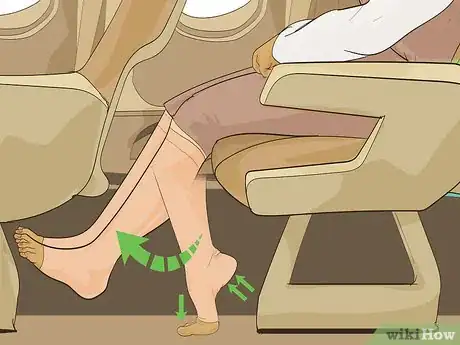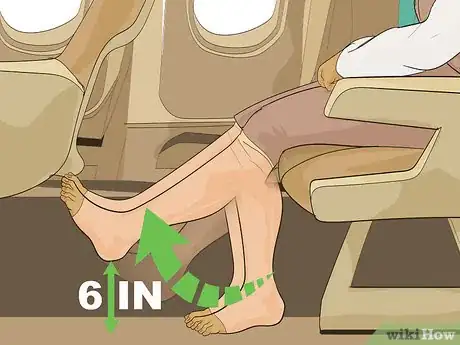This article was medically reviewed by Jennifer Boidy, RN. Jennifer Boidy is a Registered Nurse in Maryland. She received her Associate of Science in Nursing from Carroll Community College in 2012.
There are 14 references cited in this article, which can be found at the bottom of the page.
This article has been viewed 24,059 times.
One of the risks of long-distance flights is a blood clot forming in a vein, also known as deep vein thrombosis (DVT). One of the complications of a blood clot is pulmonary embolism, which is a serious and potentially fatal condition caused by a blood clot that travels to the lungs.[1] One in 4,500 airline passengers experiences blood clotting in-flight. The risk of blood clots is higher if you have related medical conditions or do a lot of long-distance flights over four hours in length. To reduce your risks, you should properly prepare for your flight and take precautions both during and after your flight.[2]
Steps
Preparing for Your Flight
-
1Know your risk. Certain people are at higher risk of blood clots or DVT than others. If you fall into one of the following categories, you may want to talk to your doctor about taking special precautions when traveling. Risk factors include:[3]
- Being older than 40
- Being overweight
- Not taking anticoagulant medication as prescribed
- A genetic blood clotting condition
- Having cancer or receiving cancer treatment
- Being pregnant or a recent delivery or c-section
- Taking hormone therapy or birth control pills
- Smoking
- A recent major surgery
- A broken bone in a lower body extremity (ankle, foot, leg, etc.)
-
2Ask your doctor about anticoagulant medication. Consider an injection of anticoagulant medication if you have cancer, had a recent surgery or have thrombophilia. Depending on your medical history and condition, one of the steps that could help is to take an anticoagulant medication such as heparin. An injection of heparin can thin your blood and make it less likely to clot during the long flight. Ask your doctor whether this is a good option for you.[4]Advertisement
-
3Get compression stockings. Doctor-recommended compression stockings are a good lifestyle change if you are at risk of blood clots or have an upcoming flight.[5] You should ask your doctor or pharmacist about the appropriate type of stocking, which may be a graduated compression stocking. They should go all the way up to your knee and can help improve circulation when used alongside regular exercise.[6]
-
4Book an aisle seat. An aisle seat will allow you to move your legs a little bit more during the flight, which will help improve circulation and reduce the risk of blood clots. Book your flight early so you can be sure to get an aisle seat.
- You may also be able to pay a little more for a row with extra leg room. If you can afford it, this may be another option to give yourself more space to stretch out.
-
5Avoid long, uninterrupted flights. People who travel on flights longer than four hours are at an increased risk of blood clots. If you can take a vacation or attend an event a little bit closer to home, you will reduce your risk. See if you can meet friends, family or colleagues somewhere a little closer, perhaps less than a four-hour flight away.[7]
- If a long trip is absolutely necessary, consider breaking it up with stops in between and give yourself time to rest, relax and walk about for a day or two between the legs of your trip. If it is not possible, you should at least give yourself a few hours of rest between flights. In this time, you should walk around and stretch.
Taking Precautions During Your Flight
-
1Ask to be reseated if they give you a window seat. If you have been seated at a window seat and are at risk of blood clots, you should tell the flight attendants. Ask one of the flight attendants if they would be able to move you to an aisle seat.[8]
-
2Store your luggage overhead. If you have carry on baggage, you should place it in the overhead container. Avoid putting anything at your feet, since it will reduce the amount of room that you have for stretching your legs.[9]
-
3Avoid drinking alcohol. You should avoid alcohol both prior to your flight and during the actual flight, since it could put you to sleep and cause you to be immobile for a long period of time. A blood clot could form while you are sleeping in an uncomfortable position.[10]
-
4Avoid sleeping pills on long flights. If you take a sleeping pill, you could fall asleep and get a blood clot. As such, avoid the temptation of taking a sleeping pill. Instead, you could try taking very short, ten-minute naps.[11]
-
5Stay hydrated by drinking plenty of water. Bring a water bottle with you. When you finish it, ask the flight attendant to refill it for you. If you rely on the small cups of water they give you during the flight, you will not get adequate hydration.
-
6Take off your shoes during the flight. To improve circulation, it can help to take off your shoes. It will be easier to stretch your feet and toes without shoes.
-
7Don’t cross your legs during the flight. If you have a habit of crossing your legs, you should avoid it during a long flight. Crossing your legs will reduce circulation to parts of your legs, which will increase the risk of a blood clot.[12]
Moving Around
-
1Do foot stretches. Flex your toes back towards your chest. Then, point them towards the ground. Repeat this exercise six to eight times for one set of foot stretches. Every once in awhile, say every half hour, you should perform this foot stretch.
-
2Stretch your toes. Every so often, you should do a simple toe stretch by pressing your toes to the ground and then raising them up to the ceiling. Complete five to eight repetitions. You can do the toe stretch after doing your foot stretch.[13]
-
3Pull your knees to your chest. Grab your knee and pull your leg up to your chest. Hold it for 15 seconds. Then, let it back down to the floor. Repeat the movement on your other side for one complete repetition. Complete 10 repetitions during your flight.[14]
-
4Press the balls of your feet to the ground periodically. Every once in awhile, you should press the balls of your feet to the ground. Press down to the floor to increase the circulation to your lower legs and feet.[15]
-
5Roll your ankles. Roll your right ankle in a clock-wise direction. Then, roll it in a counter-clockwise direction. Once you have rolled it in each direction, you have completed one repetition. Complete six repetitions per foot.[16]
-
6Lift your legs. Engage your core and lift your legs off the ground. Try lifting them 6 inches off the ground. Hold them up for 30 seconds or as long possible. Relax, and place your feet back on the ground. Repeat this exercise six times.[17]
-
7Walk up and down the aisle. Whenever you see the seat belt sign go off, you should take the opportunity to walk up and down the aisles. Walk slowly to ensure safety. Take your time and just stretch your legs by walking up and down the aisles. Every 20 minutes, walk up and down the aisles for a couple minutes (this is another reason why it's a good idea to get an aisle seat).[18]
Taking Precautions after a Flight
-
1Go for a walk right after the trip. To improve your circulation after a long flight, it is important to take a nice walk. You will likely have to walk to pick up your luggage, which will help a little bit. In addition, you could take a walk outside when you get to your destination.[19]
-
2Seek medical attention for deep vein thrombosis. If you feel pain or swelling in either of your feet or legs, you should seek immediate medical attention.
- If there is some minor puffiness in your ankles or legs but no pain or any other unusual symptoms, you don’t need to worry. Slight puffiness is not due to blood clotting and is normal with long flights.[20]
-
3See a doctor if you experience symptoms of a pulmonary embolism. A pulmonary embolism occurs when a blood clot blocks an artery in your lungs. This blood clot often originates in a person's legs and travels to their lungs. You should seek immediate medical attention if you experience any of the symptoms of a pulmonary embolism such as chest pain or shortness of breath. Likewise, see a doctor if you feel dizzy, start coughing up blood or have difficulty breathing.[21]
- Pulmonary embolism can be a fatal complication of blood clots.[22]
References
- ↑ https://emedicine.medscape.com/article/300901-overview
- ↑ http://www.npr.org/templates/story/story.php?storyId=12593776
- ↑ https://my.clevelandclinic.org/health/diseases/15802-pulmonary-embolism-who-is-at-risk
- ↑ http://patient.info/health/preventing-dvt-when-you-travel
- ↑ https://www.utphysicians.com/ease-your-travel-worries-how-compression-socks-can-provide-comfort/
- ↑ https://www.healthnavigator.org.nz/health-a-z/d/dvt-travel-related/
- ↑ http://www.npr.org/templates/story/story.php?storyId=12593776
- ↑ https://www.ncbi.nlm.nih.gov/pmc/articles/PMC8747816/
- ↑ http://www.hematology.org/Patients/Clots/Travel.aspx
- ↑ https://www.jal.co.jp/en/health/flying/
- ↑ http://www.npr.org/templates/story/story.php?storyId=12593776
- ↑ http://www.hematology.org/Patients/Clots/Travel.aspx
- ↑ https://familydoctor.org/condition/deep-vein-thrombosis/
- ↑ https://www.cdc.gov/ncbddd/dvt/travel.html
- ↑ https://www.stoptheclot.org/travel/in-flight-fitness/
- ↑ https://www.stoptheclot.org/travel/in-flight-fitness/
- ↑ https://www.cdc.gov/ncbddd/dvt/travel.html
- ↑ https://wwwnc.cdc.gov/travel/page/dvt
- ↑ https://www.healthnavigator.org.nz/health-a-z/d/dvt-travel-related/
- ↑ http://patient.info/health/preventing-dvt-when-you-travel
- ↑ https://my.clevelandclinic.org/health/diseases/15802-pulmonary-embolism-who-is-at-risk
- ↑ https://utswmed.org/medblog/pulmonary-embolism-pregnancy/





























-Step-13.webp)

-Step-16.webp)
















































Medical Disclaimer
The content of this article is not intended to be a substitute for professional medical advice, examination, diagnosis, or treatment. You should always contact your doctor or other qualified healthcare professional before starting, changing, or stopping any kind of health treatment.
Read More...